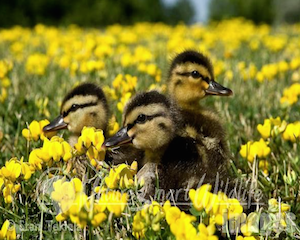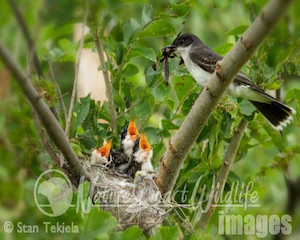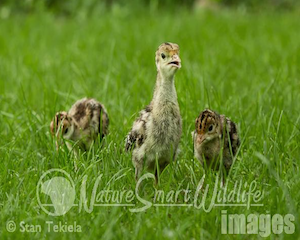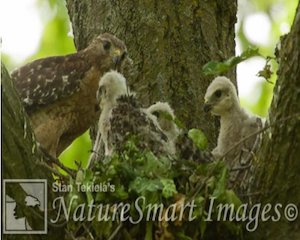
Big Birds, Baby Birds, Birds Everywhere
 All of nature seems to be in reproductive overdrive or, perhaps more accurately, hyperdrive. Just look around: Baby birds seem to be everywhere. And adult birds are busy all day trying to fill the mouths of their begging fledglings.
All of nature seems to be in reproductive overdrive or, perhaps more accurately, hyperdrive. Just look around: Baby birds seem to be everywhere. And adult birds are busy all day trying to fill the mouths of their begging fledglings.
The rush for reproduction is bases on a limited amount of time to get the job done. I don’t think it is well understood that most birds only reproduce once per year in the spring. Yes, some of our smaller species of birds will reproduce twice each season, but the point is that they only reproduce in spring. They don’t migrate down south at the end of summer and start reproducing all over again.
Many of our larger species, such as Osprey, Bald Eagle, and the Common Loon, only get one shot at reproduction each season. If something happens to their eggs or babies, then it’s all over until next year. Many of our smaller birds, such as sparrows, wrens, and finches, often nest twice per season, but at the end of summer they are done and don’t reproduce until the next spring.
 So these baby birds that we see all around us are very precious to the adult birds. The adults put a lot of effort into the survival of each one of their babies. It all starts with the time and energy it takes to build the nest. Then add the amount of energy in terms of nutrients that the female sacrifices to produce each egg, the crazy amount of time involved in incubating the eggs, and the immense time and effort gathering food and feeding the young.
So these baby birds that we see all around us are very precious to the adult birds. The adults put a lot of effort into the survival of each one of their babies. It all starts with the time and energy it takes to build the nest. Then add the amount of energy in terms of nutrients that the female sacrifices to produce each egg, the crazy amount of time involved in incubating the eggs, and the immense time and effort gathering food and feeding the young.
These are the thoughts that are passing across my mind lately while leading my Common Loon photography tours. About a dozen or more photographers from all over the world come to my headquarters in Minnesota for an opportunity to photograph loons with their babies. In addition, I also explain the finer points of loon biology and behavior while we capture amazing images of loons.
 Every year while photographing the loons, I’m completely and totally impressed with the dedication and skill the adult loons display while raising their babies. For example, just the other day we watched and photographed an adult pair of loons capturing tiny minnows, no longer than an inch, to feed their baby. The adult birds are more than 3 feet long from tip of bill to end of tail, yet they manage to catch the tiniest of fish to feed their babies. Some of the fish they catch are so small you can barely see them in the adult’s huge bill.
Every year while photographing the loons, I’m completely and totally impressed with the dedication and skill the adult loons display while raising their babies. For example, just the other day we watched and photographed an adult pair of loons capturing tiny minnows, no longer than an inch, to feed their baby. The adult birds are more than 3 feet long from tip of bill to end of tail, yet they manage to catch the tiniest of fish to feed their babies. Some of the fish they catch are so small you can barely see them in the adult’s huge bill.
When the babies are small, they are not very coordinated; when the adults pass the fish to the baby, more times than not, the baby will drop the fish. The parents are right there to grab the minnow again and return it to the baby. This can happen upwards of five times just to get the baby to swallow the fish.
One evening, we watched and photographed two adult loons bring more than 40 tiny fish to their single baby. It took nearly 30 minutes to catch each of these fish and swim back to the waiting chick and pass off the fish meal. I kept thinking to myself, how many fish can this tiny baby loon hold in its stomach? At the end of the feeding session, the baby stopped eating, but this didn’t stop the parents from still offering more fish to the baby.
 Eventually, the parents got the message that junior wasn’t hungry anymore. The baby then crawled up on the female’s back and quickly fell asleep. The male slipped off to some deeper water to do some fishing for larger fish for himself while the female did babysitting duties.
Eventually, the parents got the message that junior wasn’t hungry anymore. The baby then crawled up on the female’s back and quickly fell asleep. The male slipped off to some deeper water to do some fishing for larger fish for himself while the female did babysitting duties.
If you are interested in joining me on a loon adventure, see my web page for more details. Until next time…
If you enjoyed Stan’s post, you may consider one of his amazing nature books: Majestic Eagles; The Lives of Wolves, Coyotes, and Foxes; or Backyard Birds: Welcomed Guests at our Gardens and Feeders. Young readers will delight in his award-winning children’s books, such as Whose Butt?, Critter Litter, and his latest, Jump, Little Wood Ducks.
You can follow Stan on Facebook and Twitter, or contact him via his web page. Stan’s nationally syndicated NatureSmart Column appears in more than 25 cities spanning 5 states (Minnesota, Wisconsin, Michigan, Illinois, and Pennsylvania) and is circulated to more than 750,000 readers. Stan’s author page on Amazon features some amazing videos! Check them out, and follow him for updates.
For more stories about wildlife and nature, sign up for our newsletter now!
More posts from Stan:
Indigo Bunting—A Familiar Summer Visitor
The Nesting Behaviors of Sandhill Cranes
Big Birds, Baby Birds, Birds Everywhere
Stan Tekiela observes Marsh Wrens
The Magical, Mystical World of Sandhill Cranes



Pingback: Bird-Watching Gets Kids Outdoors - Adventure Publications
Pingback: The Northern Goshawk, a Secretive Bird - Adventure Publications
Pingback: The Virginia Opossum is One of the Coolest Critters - Adventure Publications
Pingback: Wild Birds: THE Book for Bird-watchers - Adventure Publications
Pingback: Diver, Dipper, Bobber, Blinker - Adventure Publications
Pingback: The Oystercatcher Sleeps with One Eye Open - Adventure Publications
Pingback: Stan Tekiela Photographs Bighorns in Wyoming - Adventure Publications
Pingback: Watch Out, Roadrunner Sprinter Approaching! - Adventure Publications
Pingback: Our Love of Owls—A New Book by Stan Tekiela - Adventure Publications
Pingback: Bird Trivia: Amazing Facts to Wow Any Bird Lover - Adventure Publications
Pingback: Grebes are Rushing and Dancing on the Water - Adventure Publications
Pingback: A Blue Jay Picture Worth Waiting For - Adventure Publications
Pingback: Indigo Bunting—A Familiar Summer Visitor - Adventure Publications
Pingback: March Chores and Maple Syrup - Adventure Publications